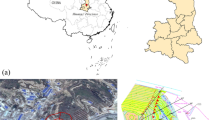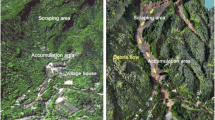Abstract
A catastrophic loess flow slide was triggered by the 2013 Minxian–Zhangxian earthquake in Yongguang village, Minxian County, Gansu Province, China. The landslide destroyed eight houses and killed 12 persons. The landslide involved the failure of 14.0 × 104 m3 of loess deposits from the source area. The displaced materials traveled 1000 m with an elevation descent of 180 m, covering an area of 4.2 × 104 m2. A numerical model (DAN3D) is used to simulate the post-failure behavior of the landslide based on a detailed field investigation. A combination of the frictional model and Voellmy model provides the best performance in simulating the landslide using trial and error. The simulation results indicate that the landslide lasted approximately 120 s and had an average velocity of 8.3 m/s. The final runout distance and deposit distribution are in a good agreement with the actual situation, indicating the accuracy of the simulated results. Therefore, it is expected that the models and parameters could improve the precision of hazard zonation for areas with geological, topographical, and climatic features similar to the Yongguang landslide area.










Similar content being viewed by others
References
Acharya G, Cochrane T, Davies T, Bowman E (2011) Quantifying and modeling post failure sediment yields from laboratory-scale soil erosion and shallow landslide experiments with silty loess. Geomorphology 129:49–58
Boultbee N (2005) Characterization of the Zymoetz River rock avalanche. M.Sc. thesis, Simon Fraser University, Burnaby
Che AL, Wu ZJ, Peng D, Lei T, Chen T (2013) Surface wave investigation and dynamic stability analysis for earthquake-induced loess landslides. China Earthq Eng J 35(4):724–729 (in Chinese)
Chen H, Lee CF (2003) A dynamic model for rainfall-induced landslides on natural slopes. Geomorphology 51(4):269–288
Corominas J (1996) The angle of reach as a mobility index for small and large landslides. Can Geotech J 33:260–271
Derbyshire E (2001) Geological hazards in loess terrain, with particular reference to the loess regions of China. Earth Sci Rev 54:231–260
Evans SG, Hungr O, Clague JJ (2001) Dynamics of the 1984 rock avalanche and associated distal debris flow on mount Cayley, British Columbia, Canada; implications for landslide hazard assessment on dissected volcanoes. Eng Geol 61:29–51
Evans SG, Guthrie RH, Roberts NJ, Bishop NF (2007) The disastrous 17 February 2006 rockslide-debris avalanche on Leyte Island, Philippines: a catastrophic landslide in tropical mountain terrain. Nat Hazard Earth Syst 7:89–101
Heller F, Honggerberg ETH, Evans ME (1995) Loess magnetism. Rev Geophys 33(2):211–240
Huang RQ (2009) Some catastrophic landslides since the twentieth century in the southwest of China. Landslides 6:69–81
Huang RQ, Pei XJ, Fan XM, Zhang WF (2012) The characteristics and failure mechanism of the largest landslide triggered by the Wenchuan earthquake, may 12, 2008, China. Landslides 9:131–142
Hungr O (1995) A model for the runout analysis of rapid flow slides, debris flows, and avalanches. Can Geotech J 32(4):610–623
Hungr O, Evans SG (1996) Rock avalanche run out prediction using a dynamic model. In: Senneset (Ed.), Landslides: Proc Int Symp, Trondheim, 1:233–238
Hungr O, Evans SG (2004) Entrainment of debris in rock avalanches: an analysis of a long run-out. Geol Soc Am Bull 116(9-10):1240–1252
Hungr O, McDougall S, Bovis M (2005) Entrainment of material by debris flows. In: Jakob & Hungr (eds.) Debris flow hazards and related phenomena pp 135–158. Springer, Heidelberg
Li TL, Wang P, Xi Y (2013) The mechanisms for initiation and motion of Chinese loess landslides. In: Wang F et al (eds) Progress of geo-disaster mitigation technology in Asia. Environmental science and engineering. Springer, Berlin, pp 105–122
Liu TS (1985) Loess and the environment. China Ocean Press, Beijing, p 251
Meng XM, Derbyshire E (1998) Landslides and their control in the Chinese loess plateau: models and case studies from Gansu Province, China. In: Maund JD and Eddleston M (eds.) Geohazards in engineering geology. Geol Soc London Eng Geol Spec Publ 15:141–153
McDougall S, Hungr O (2004) A model for the analysis of rapid landslide motion across three-dimensional terrain. Can Geotech J 41(6):1084–1097
McDougall S, Hungr O (2005) Dynamic modelling of entrainment in rapid landslides. Can Geotech J 42(5):1437–1448
McDougall S, Boultbee N, Hungr O, Stead D, Schwab JW (2006) The Zymoetz River landslide, British Columbia, Canada: description and dynamic analysis of a rock slide-debris flow. Landslides 3:195–204
Ouyang CJ, He S, Tang C (2015) Numerical analysis of dynamics of debris flow over erodible beds in Wenchuan earthquake-induced area. Eng Geol 194:62–72
Pastor M, Blanc T, Haddad B, Petrone S, Sanchez MM, Drempetic V, IssIer D, Crosta GB, Cascini L, Sorbino G, Cuomo S (2014) Application of a SPH depth-integrated model to landslide run-out analysis. Landslides 11:793–812
Peng J, Fan Z, Wu D, Zhuang J, Dai F, Chen W, Zhao C (2015) Heavy rainfall triggered loess-mudstone landslide and subsequent debris flow in Tianshui, China. Eng Geol 186:79–90
Scheidegger AE (1973) On the prediction of the reach and velocity of catastrophic landslides. Rock Mech 5:231–236
Shroder JF, Schettler MJ, Weihs BJ (2011) Loess failure in Northeast Afghanistan. Phys Chem Earth 36:1287–1293
Sosio R, Crosta GB, Hungr O (2008) Complete dynamic modeling calibration for the Thurwieser rock avalanche (Italian Central Alps). Eng Geol 100(1-2):11–26
Wang GH, Zhang DX, Furuya G, Yang J (2014a) Pore-pressure generation and fluidization in a loess landslide triggered by the 1920 Haiyuan earthquake, China: a case study. Eng Geol 174:36–45
Wang GL, Li TL, Xing XL, Zou Y (2015) Research on loess flow-slides induced by rainfall in July 2013 in Yan’an, NW China. Environ Earth Sci 73(12):7933–7944
Wang JJ, Liang Y, Zhang HP, Wu Y, Lin X (2014b) A loess landslide induced by excavation and rainfall. Landslides 11(1):141–152
Wang WP, Yin YP, Zhu SN, Wei YJ, Zhang N, Yan JK (2018) Dynamic analysis of a long-runout, flow-like landslide at Areletuobie, Yili River valley, northwestern China. Bull Eng Geol Environ. https://doi.org/10.1007/s10064-018-1322-6
Wu Z, Sun J, Chen Y, Wang Q, Zhao W (2015) Analysis of disaster-causing mechanism of loess landslides induced by the Minxian–Zhangxian MS6. 6 earthquake, China. Jpn Geotech Soc Spec Publ 1(7):40–45
Xu C, Xu X, Shyu JBH, Zheng W, Min W (2014a) Landslides triggered by the 22 July 2013 Minxian–Zhangxian, China, mw 5.9 earthquake: inventory compiling and spatial distribution analysis. J Asian Earth Sci 92:125–142
Xu L, Dai FC, Tu XB, Zhou YF, Tham LG, Iqbal J (2014b) Landslides in a loess platform, north-West China. Landslides 11(6):993–1005
Xing A, Wang G, Li B, Jiang Y, Feng Z, Kamai T (2014) Long-runout mechanism and landsliding behavior of large catastrophic landslide triggered by heavy rainfall in Guanling, Guizhou, China. Can Geotech J 52(7):971–981
Yin Y, Xing A, Wang G, Feng Z, Li B, Jiang Y (2017) Experimental and numerical investigations of a catastrophic long-runout landslide in Zhenxiong, Yunnan, southwestern China. Landslides 14:649–659
Zhang DX, Wang GH, Luo CY, Chen J, Zhou YX (2009) A rapid loess flowslide triggered by irrigation in China. Landslides 6(1):55–60
Acknowledgements
This study was supported by the National Natural Science Foundation of China (No. 41530639 and 41272382). We are grateful to Prof. O. Hungr for supplying a copy of the DAN3D software and Prof. Che Ailan for providing the data of Rayleigh-wave exploration.
Author information
Authors and Affiliations
Corresponding author
Rights and permissions
About this article
Cite this article
Zhuang, Y., Xing, A., Cheng, Q. et al. Characteristics and numerical modeling of a catastrophic loess flow slide triggered by the 2013 Minxian–Zhangxian earthquake in Yongguang village, Minxian, Gansu, China. Bull Eng Geol Environ 79, 439–449 (2020). https://doi.org/10.1007/s10064-019-01542-x
Received:
Accepted:
Published:
Issue Date:
DOI: https://doi.org/10.1007/s10064-019-01542-x




